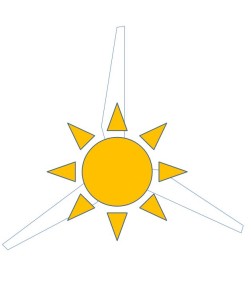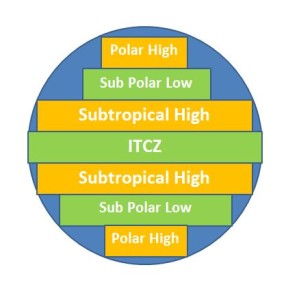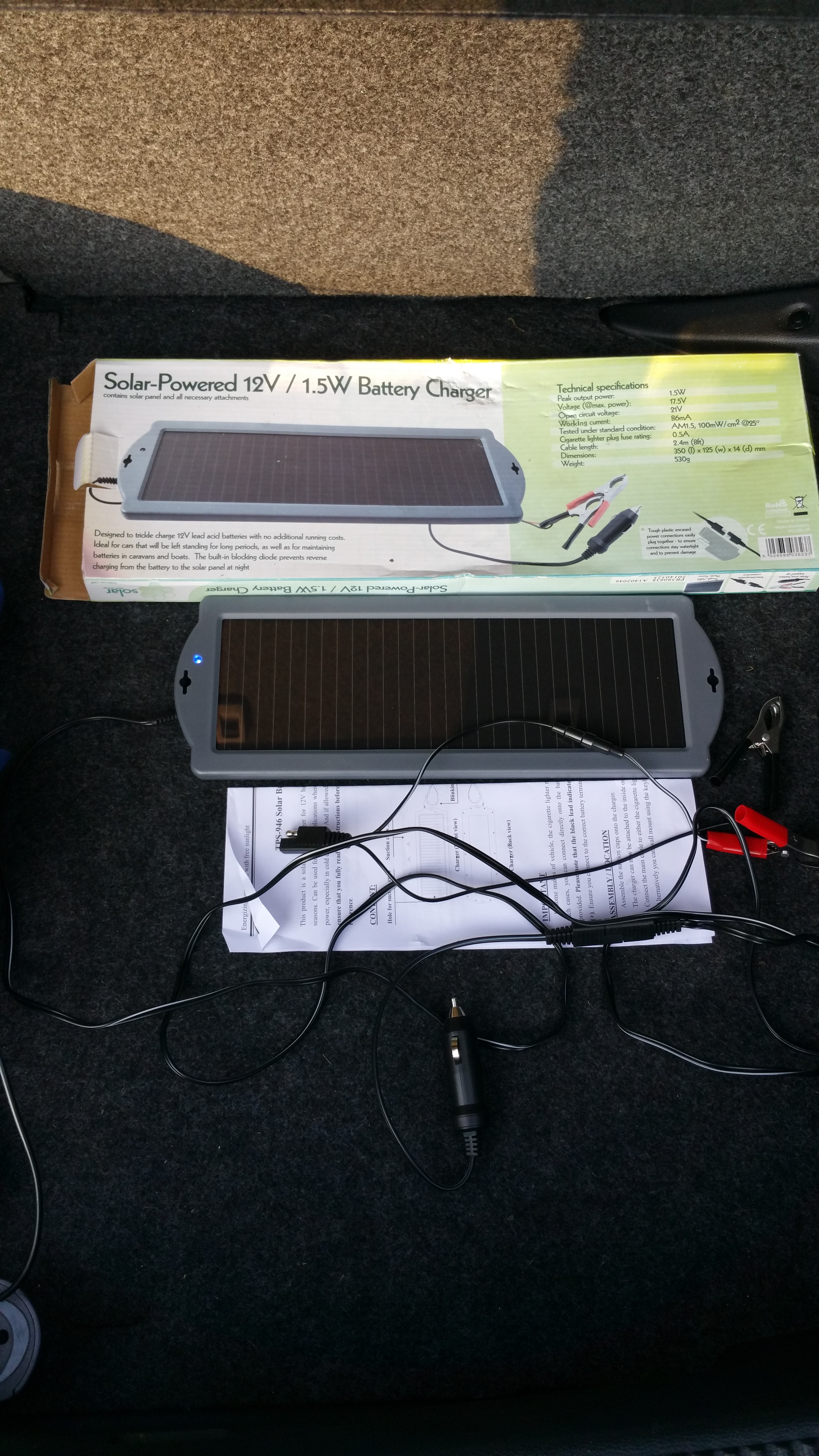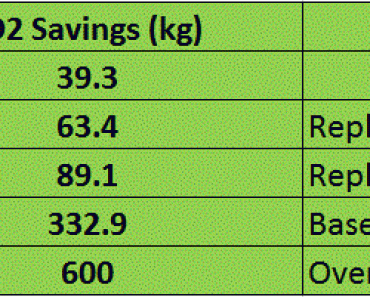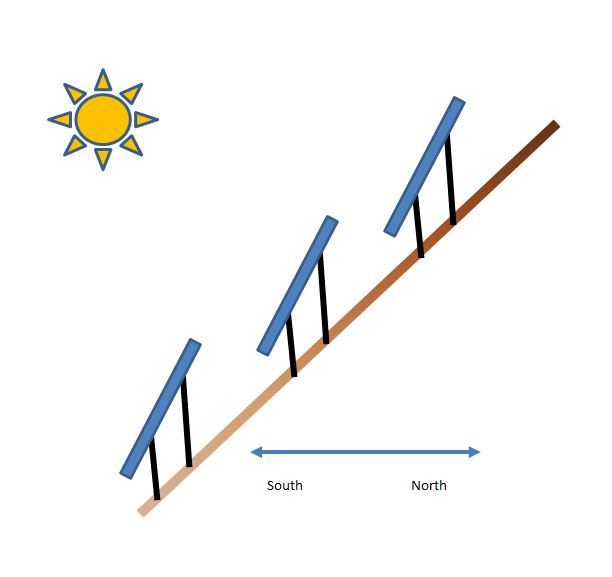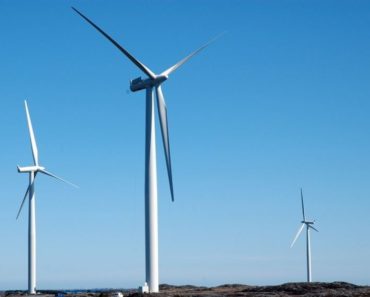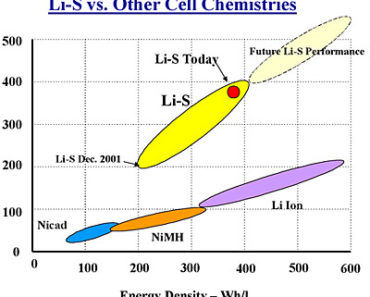Using solar and wind energy in tandem has many benefits. Not only it produces a more robust system but also improves the security of supply. Through experience one can note that windy and sunny weather conditions often don’t go hand in hand.
In meteorological terms, high barometric pressure corresponds to still wind conditions, patchy cloud cover if any and ample sunshine. On the other hand, low pressure corresponds to windier conditions and often thick cloud cover.
There are regions on earth that are occupied predominantly by high pressure while other regions experience low pressure conditions for most part of the year. In terms of renewable energy, low pressure means a higher yield for the wind turbines while high pressure equates to higher yield for the solar PV array.
In order to identify the zones that experience predominantly high and low pressures, imaginary zones have been created on the globe. On and near the equator, there is a belt where predominantly low pressure dominates. This is called ITCZ or the Intertropical convergence zones. Contrary to the popular belief, the climate on and around the equatorial zone is not arid. In fact this region experiences extremely high precipitation (rainfall) and all the rainforests of the world are present in the zone.
ITCZ is sandwiched by regions called Subtropical High Zone. These are the regions where high pressure dominates for most part of the year. Most of the deserts of the world are present in the subtropical high zones. From Sahara to Gobi desert in the northern hemisphere to Kalahari and Patagonia in southern Hemisphere, all lie in these regions. As the name indicates these regions are dominated by atmospheric high pressure for most time during the year. This results in high solar insolation and extremely low precipitation.
The adjoining zones next to the subtropical high are the sub-polar low zones. These zones experience high wind conditions and high precipitation for across the year. The UK falls in this zone. Consequently the areas falling in these zones are lush green. These region includes most of Europe /Canada and New Zealand in the southern hemisphere.
There are regions which are at the borders of two zones. These experience both high and low pressures. In such areas, to improve the overall yield of the renewable system it makes good engineering sense to use both solar energy and wind energy in conjunction. This will mean that when high pressure occupies the region, than Solar PV will increase yield. Likewise when there will be wind, the wind turbines will lead the energy generation.
Working in tandem also means that in northern Europe, during the summer months when days are longer the solar PV provides bulk of the base load, while during the winter months wind turbine pick up the tab.
Two case studies where Solar and Wind Energy have been used in tandem have been listed here in
Mackie’s Ice-cream, Scotland
An interesting case study is Mackie’s Ltd, a family run business in Scotland that is renowned for their Ice cream products. The company owned a land area of 690 hectares in Westertown, Rothienorman, Aberdeenshire that was traditionally used for by the business for farming.
The company in 2005 installed its first wind turbine. The project was a success as the turbine was placed on one of the windiest places in Europe. Two years later in 2007, with the addition of two more turbines, the total capacity went up to 2.5 MW. The turbines provide up to 70% of the energy consumption of Mackie’s plant. Another turbine installation is on the way and will prop up the capacity to 3.0 MW.
However despite the high capacity factor of the wind turbines Mackie’s felt that it needed to further improve the consistency of their overall energy output. In the long summer days when the wind dropped, the company was more dependent on the Grid. The owners understood soon that solar energy was the missing link.
In September 2015, with installation of almost 7,000 Solar PV panels delivering a capacity of 1.8MW, Mackie’s had the biggest solar farm in Scotland.
And with the additional 400 KW Biomass plant also going online, Mackie’s are now enjoying the fruits of a more robust energy system, with a fair mix of energy resources at their disposal.
Isle of Eigg, Scotland
The Isle of Eigg is a remote Hebridian Island located near the west coast of mainland Scotland south of Isle of Skye. The community on Eigg took ownership of the Island in 1997.
The electricity for the Islands used to come form of Diesel generators. There clunky noise of the generators not only spoiled the serenity of the Island but there remained insecurity about the supply of diesel and the down time of the generator. Among the 83 residents on Eigg, there was no concept of round the clock availability electricity.
The Islanders pooled in money and received grants through which they were able to design and commission a three legged renewable energy system. They opted for wind, solar and hydro power in their energy mix while disposing diesel generators all together. Today the Island’s energy is 100% renewable. The Solar PV system at Eigg is 10 kWp while the Wind farm has the capacity of 24 kW. The Hydro Energy makes adds another 112 kW to the overall capacity.
The system ensures that during the drier months when both wind and hydro energy dropped, the Islanders still had access to energy through solar power. For continuous electrification of the Island a backup diesel generator as well as battery storage is in place.
Conclusion
Hybrid renewable systems have their advantages. Most places on earth can be classified in areas where high or low barometric pressure dominates. In regions where high pressure dominates, Solar energy can provide high yield. Likewise, where low pressure dominates wind energy can provide bulk of the base load. Using both systems in conjunction ensures energy supply even during times when conditions are adverse to the prevalent climate.

